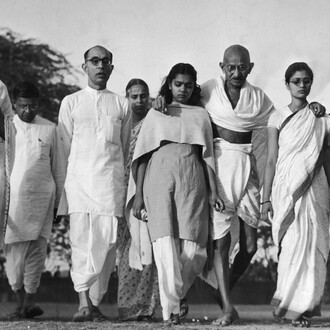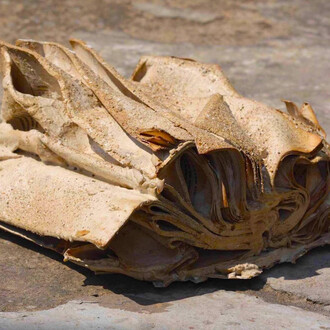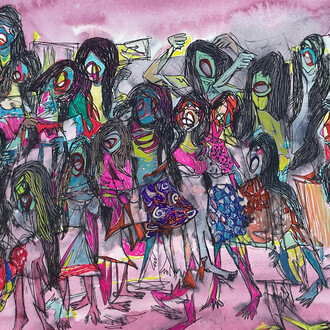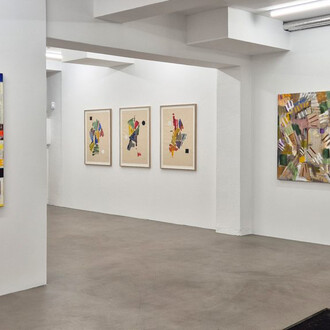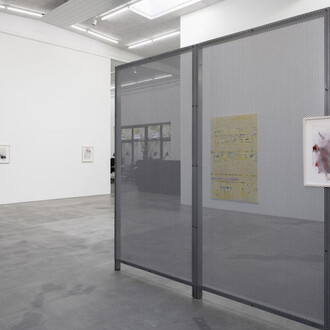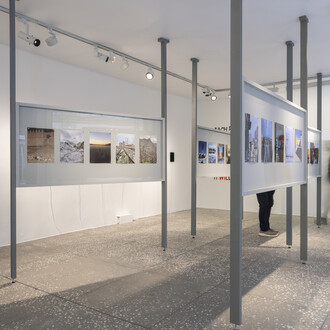Categorized in larger series, K R Sunil's practice is grounded in substantial research and an organized conceptual approach. The Thambu—Tales from the great Indian circus series on view here, sparked by a chance encounter with a circus proprietor and performer, took three years from planning to completion. Consisting of 46 black-and-white portraits of circus artists Sunil has met, each portrait is accompanied by a written testimony, offering a vivid spectrum of the bygone era of circus life. Displayed on the ground oor of Sakshi gallery, the aesthetic rigour of the portraits represents a telling mirror of the Indian circus as a social institution—an arena where languages and cultures from across the country mix, transcending societal boundaries in favour of a life in camaraderie and togetherness.
India's significant contribution to the world circus, with Kamala Circus once being the world's second-largest circus, finds a poignant revival in Sunil's portraits. The accompanying narratives of the performers are excerpts from interviews Sunil has conducted with them, forming part of an intuitive encounter over a period of time. Deploying textual and visual material as a means both to memory and participation, Sunil highlights the complementary function of image and text to shine light on the past lives of these performers. While their exceptional talents once attracted international accolades, they are now confronted with the harsh realities of poverty, marginalisation and in several cases life-impacting injuries. From a sociological angle, the magic of the circus tent was tainted by child exploitation, economic uncertainties, and unfavourable working conditions.
Alongside the portraits of the performing artists, Sunil has selected a series of prints out of an archive of more than 500 black- and-white photographs. Bearing no credentials, these photographs are mainly in the personal possessions of circus artists and serve as an authentic testimony to a period spanning the golden age of the Indian circus in the 1960s to its decline in the late 1980s. This was the time when the magic allure of the circus was steadily replaced by an increasingly consumerist entertainment sector, with the change of laws dealing a further blow to the industry.
On the second floor of Sakshi gallery, the 16-part series of colour portraits Chavittu Nadakam—Storytellers of the seashore are showcased alongside a set of backstage images that result from Sunil's extensive investigation into a cultural practice known as 'Chavittu Nadakam'. Performed by backward Dalit and shing communities that who were converted to Christianity by colonial missionaries, 'Chavittu Nadakam' is a dance-music-drama dating back to Portuguese colonial rule in South India.
Fusing ancient martial traditions of Kerala with theatre and musical practices of Renaissance Europe, the 'Chavittu Nadakam' performers wear lavishly decorated costumes, ornaments and accessories. Sunil's camera captures the sharp contrast between their sumptuous attire and poor dwellings, the latter serving as a backdrop to their proud poses. Some of the images depict family members in the background, only to shed light on the existence of a community whose precariousness is further exacerbated by the alarming rise of the sea level, with water encroaching the meagre stretch of their land and belongings.
A common thread in the Thambu—Tales from the great Indian circus and the Storytellers of the seashore series is their genesis and rootedness in Sunil's homeland Kerala. While Thalassery, a port city in Kerala, marks a significant chapter in the expansive trajectory of the Indian circus, the performers in 'Storytellers from the Seashore' hail from a limited stretch of Kerala's coastline along the Arabian Sea. Both the series reflect Sunil's preoccupation with aesthetics that are coupled with a central concern for his subjects' living conditions, their character and resilience. Preserving firsthand accounts and documentary evidence of communities that are relegated to the peripheries of official history, he opts for an inclusive way of seeing. Using the photographic lens as a work tool for enquiry and visual analysis, he creates a photographic chronicle that is comprehensive in scope and universal in depth.
(Text by Birgid Uccia)





